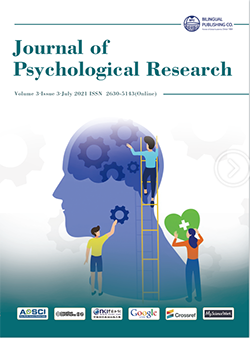-
1541
-
1345
-
1336
-
1329
-
1205
Relationship between Sexual Fantasy, Sexual Communication, Personality Traits and Sexual Satisfaction in Married Individuals
DOI:
https://doi.org/10.30564/jpr.v3i3.3483Abstract
The study aimed to understand the relationship between sexual fantasy, sexual communication, personality traits and sexual satisfaction in married individuals. Sexual fantasy as a variable has seldom been studied in the Indian context. The importance of sexual fantasies has been noted by therapists and researchers. Studying various aspects of sexual functioning in married life including, sexual communication and sexual satisfaction and personality traits would be beneficial. A cross sectional design with a total sample of 100 married individuals was considered. Tools were administered as online forms. Parametric and Non-parametric tests were used to find the correlation between Sexual fantasy and sexual satisfaction, sexual communication and sexual satisfaction and personality traits and sexual satisfaction. Results indicated that sexual fantasy and sexual satisfaction have a negative correlation, sexual communication and sexual satisfaction have a positive correlation and personality traits and sexual satisfaction also have a positive correlation. This study can be used to develop modules that might aid in marital and sex therapy. It may be useful in identifying any difficulties or issues which may help in providing appropriate timely interventionKeywords:
Sexual Fantasy, Sexual Satisfaction, Sexual Communication, Personality traits, Married individualsReferences
[1] Leitenberg, H., & Henning, K. (1995). Sexual fantasy. Psychological bulletin, 117(3), 469.
[2] Sastry, J. (1999). Household structure, satisfaction and distress in India and the United States: A comparative cultural examination. Journal of Comparative Family Studies, 30(1), 135-152.
[3] Hill, C. A. (2008). Human sexuality: Personality and social psychological perspectives. Sage.
[4] Cado, S., & Leitenberg, H. (1990). Guilt reactions to sexual fantasies during intercourse. Archives of Sexual Behavior, 19(1), 49-63.
[5] Brown, J. J., & Hart, D. H. (1977). Correlates of females’ sexual fantasies. Perceptual and Motor Skills, 45(3), 819-825.
[6] Hessellund, H. (1976). Masturbation and sexual fantasies in married couples. Archives of Sexual Behavior, 5(2), 133-147.
[7] Davidson Sr, J. K., & Hoffman, L. E. (1986). Sexual fantasies and sexual satisfaction: An empirical analysis of erotic thought. Journal of Sex Research, 22(2), 184-205.
[8] MacNeil, S., & Byers, E. S. (2005). Dyadic assessment of sexual self-disclosure and sexual satisfaction in heterosexual dating couples. Journal of Social and Personal Relationships, 22(2), 169-181.
[9] Coffelt, T., & Hess, J. (2006). The permeability of sexual topics across boundaries in marital relationships. In annual meeting of the National Communication Association, San Antonio, TX.
[10] MacNeil, S., & Byers, E. S. (2009). Role of sexual self-disclosure in the sexual satisfaction of long-term heterosexual couples. Journal of Sex Research, 46(1), 3-14.
[11] Montesi, J. L., Conner, B. T., Gordon, E. A., Fauber, R. L., Kim, K. H., & Heimberg, R. G. (2013). On the relationship among social anxiety, intimacy, sexual communication, and sexual satisfaction in young couples. Archives of sexual behavior, 42(1), 81-91.
[12] Faulkner, S. L., & Lannutti, P. J. (2010). Examiningthe content and outcomes of young adults’ satisfying and unsatisfying conversations about sex. Qualitative Health Research, 20(3), 375-385.
[13] Donovan-Kicken, E., & Caughlin, J. P. (2010). A multiple goals perspective on topic avoidance and relationship satisfaction in the context of breast cancer. Communication Monographs, 77(2), 231-256.
[14] Caughlin, J. P., Afifi, W. A., Carpenter-Theune, K. E., & Miller, L. E. (2005). Reasons for, and consequences of, revealing personal secrets in close relationships: A longitudinal study. Personal Relationships, 12(1), 43-59.
[15] Tiefer, L. (2004). Sex is not a natural act & other essays. Westview Press.
[16] Renaud, C. A., & Byers, E. S. (2001). Positive and negative sexual cognitions: Subjective experience and relationships to sexual adjustment. Journal of Sex Research, 38(3), 252-262.
[17] Farley, F. H., & Davis, S. A. (1980). Personality and sexual satisfaction in marriage. Journal of sex & marital therapy, 6(1), 56-62.
[18] Rosen, R. C., Riley, A., Wagner, G., Osterloh, I. H., Kirkpatrick, J., & Mishra, A. (1997). The international index of erectile function (IIEF): a multidimensional scale for assessment of erectile dysfunction. Urology, 49(6), 822-830.
[19] Wiegel, M., Meston, C., & Rosen, R. (2005). Thefemale sexual function index (FSFI): cross-validation and development of clinical cutoff scores. Journal of sex & marital therapy, 31(1), 1-20.
[20] Giambra, L. M., & Singer, J. L. (2013). Sexual Daydreaming Scale of the imaginal processes inventory. In Handbook of sexuality-related measures (pp. 282- 284). Routledge.
[21] Davis, C. M., Yarber, W. L., Bauserman, R., Schreer, G., & Davis, S. L. (1998). Handbook of sexuality-related measures. Sage.
[22] LAWRANCE, K. A., & Byers, E. S. (1995). Sexual satisfaction in long-term heterosexual relationships: The interpersonal exchange model of sexual satisfaction. Personal relationships, 2(4), 267-285.
[23] Sato, T. (2005). The Eysenck personality questionnaire brief version: Factor structure and reliability. The Journal of psychology, 139(6), 545-552.
[24] Sonpar, S. (2005). Marriage in India: clinical issues. Contemporary Family Therapy, 27(3), 301-313.
[25] Kakar, S. (2008). Culture and psyche: Selected essays. Oxford University Press.
[26] Pothen, S. (1989). Divorce in Hindu society. Journal of Comparative Family Studies, 20(3), 377-392.
[27] Cupach, W. R., & Metts, S. (2014). Sexuality and communication in close relationships. In Sexuality in close relationships (pp. 109-126). Psychology Press.




 Rhea Dhir
Rhea Dhir





